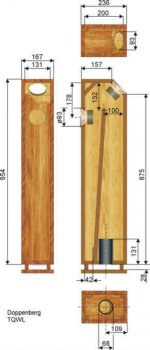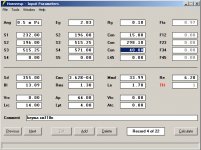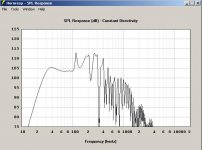Hello all,
I've been quite busy at work the last week so I didn't have much time to play around with horns. I still didn't manage to do any measurements outside, so I don't know it there are still room artifacts in my measurements.
Here is the Akakabak script which adds a little more damping to the simulation. It is a very simple script based on a number of straight ducts forming the horn.
Def_Driver 'Dr1'
| W8-740P
Sd=220cm2
Bl=13.35Tm
Cms=3.33e-4m/N
Rms=1.62Ns/m
Mms=0.095kg
Le=0.0318H
Re=3.2ohm
Def_Driver 'Dr2'
| W8-740P
Sd=220cm2
Bl=13.35Tm
Cms=3.33e-4m/N
Rms=1.62Ns/m
Mms=0.095kg
Le=0.0318H
Re=3.2ohm
system 'S1'
Driver Def='Dr1' Node=1=20=3=13
Driver Def='Dr2' Node=20=0=3=13
Duct 'D1' Node=2=3 HD=24.5cm WD=10cm Len=23cm visc=50
Duct 'D2' Node=3=4 HD=24.5cm WD=12cm Len=42cm visc=50
Duct 'D3' Node=4=5 HD=24.5cm WD=13cm Len=50cm visc=50
Duct 'D4' Node=5=6 HD=24.5cm WD=14cm Len=50cm visc=1
Duct 'D5' Node=6=7 HD=24.5cm WD=16cm Len=50cm visc=1
Duct 'D6' Node=7=8 HD=24.5cm WD=18cm Len=50cm visc=1
Duct 'D7' Node=8=9 HD=24.5cm WD=21cm Len=50cm visc=1
Duct 'D8' Node=9=10 HD=24.5cm WD=24cm Len=50cm visc=1
Duct 'D9' Node=10=11 HD=24.5cm WD=27cm Len=50cm visc=1
Duct 'D10' Node=11=12 HD=24.5cm WD=31cm Len=50cm visc=1
Duct 'D11' Node=12=13 HD=24.5cm WD=34cm Len=50cm visc=1
Duct 'D12' Node=13=14 HD=24.5cm WD=35cm Len=50cm visc=20
Duct 'D13' Node=14=15 HD=24.5cm WD=36cm Len=40cm visc=1
Radiator 'R1' Def='D7' Node=15
I've been quite busy at work the last week so I didn't have much time to play around with horns. I still didn't manage to do any measurements outside, so I don't know it there are still room artifacts in my measurements.
Here is the Akakabak script which adds a little more damping to the simulation. It is a very simple script based on a number of straight ducts forming the horn.
Def_Driver 'Dr1'
| W8-740P
Sd=220cm2
Bl=13.35Tm
Cms=3.33e-4m/N
Rms=1.62Ns/m
Mms=0.095kg
Le=0.0318H
Re=3.2ohm
Def_Driver 'Dr2'
| W8-740P
Sd=220cm2
Bl=13.35Tm
Cms=3.33e-4m/N
Rms=1.62Ns/m
Mms=0.095kg
Le=0.0318H
Re=3.2ohm
system 'S1'
Driver Def='Dr1' Node=1=20=3=13
Driver Def='Dr2' Node=20=0=3=13
Duct 'D1' Node=2=3 HD=24.5cm WD=10cm Len=23cm visc=50
Duct 'D2' Node=3=4 HD=24.5cm WD=12cm Len=42cm visc=50
Duct 'D3' Node=4=5 HD=24.5cm WD=13cm Len=50cm visc=50
Duct 'D4' Node=5=6 HD=24.5cm WD=14cm Len=50cm visc=1
Duct 'D5' Node=6=7 HD=24.5cm WD=16cm Len=50cm visc=1
Duct 'D6' Node=7=8 HD=24.5cm WD=18cm Len=50cm visc=1
Duct 'D7' Node=8=9 HD=24.5cm WD=21cm Len=50cm visc=1
Duct 'D8' Node=9=10 HD=24.5cm WD=24cm Len=50cm visc=1
Duct 'D9' Node=10=11 HD=24.5cm WD=27cm Len=50cm visc=1
Duct 'D10' Node=11=12 HD=24.5cm WD=31cm Len=50cm visc=1
Duct 'D11' Node=12=13 HD=24.5cm WD=34cm Len=50cm visc=1
Duct 'D12' Node=13=14 HD=24.5cm WD=35cm Len=50cm visc=20
Duct 'D13' Node=14=15 HD=24.5cm WD=36cm Len=40cm visc=1
Radiator 'R1' Def='D7' Node=15
ik vond op internet dit stukje over de TQWT welke sterk lijkt op de tapped horn.
hier maken ze gebruik van een extra pijp en driver afgestemd op 2e harmonischen.
maar als ik zo kijk lijkt die stub daar ook wel op.
wou het toch even plaatsen voor de info.
The main problem of the TQWT is that it will produce a combfilter effect due to line resonances at lower frequencies, certain bass notes would be near inaudible, other would boom way too much, a very uneven and lumpy bass response. The only way to reduce these line resonances is to stuff the line severely, which changes air speed and therefore acts as prolongated line, but at the same time kills efficiency. The notches are caused by line harmonics cancelling the output from the drivers front. They correspond to impedance curve peaks which can be easily seen on a plot.
There is fortunately another option. Instead of troublesome tuning, two or more pipes can be employed in one enclosure, possibly even with different drivers. One pipe should be tuned exactly 1/2 octave below the other, once the minimal stuffing in the throat (the narrowes point in the tapered tube) is taken into account. The trick is to have a major port resonance at the lowest frequency desired (essentially the driver's resonance). The pipe resonance will likely be somewhat higher than that. The port then needs a second "parasitic" (pipe type) resonance at the second harmonics of the line resonance. Normally this (2nd harmonic) resonance is out of phase with the driver's front radiation and hence creates a cancellation, the source of the deepest and lowest notch. This means the "parasitic" and normally unwanted resonance of a classic port is desired. What it does is to simply remove energy from the pipe at the the 2nd harmonic. In any case, now one pipe will have a "peak" wherever the other has a dip. If this is well calculated such enclosure will deal well with the resonanes, having a much flatter impedance curve and a fairly flat frequency response. This procedure should provide a deep and tight bass with a pretty even response.
hier maken ze gebruik van een extra pijp en driver afgestemd op 2e harmonischen.
maar als ik zo kijk lijkt die stub daar ook wel op.
wou het toch even plaatsen voor de info.
The main problem of the TQWT is that it will produce a combfilter effect due to line resonances at lower frequencies, certain bass notes would be near inaudible, other would boom way too much, a very uneven and lumpy bass response. The only way to reduce these line resonances is to stuff the line severely, which changes air speed and therefore acts as prolongated line, but at the same time kills efficiency. The notches are caused by line harmonics cancelling the output from the drivers front. They correspond to impedance curve peaks which can be easily seen on a plot.
There is fortunately another option. Instead of troublesome tuning, two or more pipes can be employed in one enclosure, possibly even with different drivers. One pipe should be tuned exactly 1/2 octave below the other, once the minimal stuffing in the throat (the narrowes point in the tapered tube) is taken into account. The trick is to have a major port resonance at the lowest frequency desired (essentially the driver's resonance). The pipe resonance will likely be somewhat higher than that. The port then needs a second "parasitic" (pipe type) resonance at the second harmonics of the line resonance. Normally this (2nd harmonic) resonance is out of phase with the driver's front radiation and hence creates a cancellation, the source of the deepest and lowest notch. This means the "parasitic" and normally unwanted resonance of a classic port is desired. What it does is to simply remove energy from the pipe at the the 2nd harmonic. In any case, now one pipe will have a "peak" wherever the other has a dip. If this is well calculated such enclosure will deal well with the resonanes, having a much flatter impedance curve and a fairly flat frequency response. This procedure should provide a deep and tight bass with a pretty even response.
Hi geitmans hmm sounds dutch?
oke , yes I now it is nog a tapered horn, vut so I read it is 95 procent identical.
maybe it is nice to do with the tapered horn the same way with a extra pipe tuned to f2.
so you can have a horn 15 hz, and the second pipe on 30 hz to expand it to three octaves.
this I saw on the stud.
greetz kees
oke , yes I now it is nog a tapered horn, vut so I read it is 95 procent identical.
maybe it is nice to do with the tapered horn the same way with a extra pipe tuned to f2.
so you can have a horn 15 hz, and the second pipe on 30 hz to expand it to three octaves.
this I saw on the stud.
greetz kees
here is the link where I read it.
http://yu-ra.tripod.com/tqwta.htm
further I have no information.
we have to simulate it with hornresp.
I have not much experience with loudspeakers, only with amps but read some about it.
but to correct the specs of the enclosure we need to experiment with the second pipe to get 3 octaves.
http://yu-ra.tripod.com/tqwta.htm
further I have no information.
we have to simulate it with hornresp.
I have not much experience with loudspeakers, only with amps but read some about it.
but to correct the specs of the enclosure we need to experiment with the second pipe to get 3 octaves.
Hi all
the th-spud has to be tuned differend that is also tryed by geitmans , so | read horn 1 to the fundamental and horn to to f2 but you can try also f3 or f4 so it will fill up the dips and give 3 octaves like the real spud do who has a very nice spec to 125 hz, maybe horn 2 is to short.
correct me if I wrong.
but still a very good project.
the th-spud has to be tuned differend that is also tryed by geitmans , so | read horn 1 to the fundamental and horn to to f2 but you can try also f3 or f4 so it will fill up the dips and give 3 octaves like the real spud do who has a very nice spec to 125 hz, maybe horn 2 is to short.
correct me if I wrong.
but still a very good project.
Hi kees52,
I'm indeed from the dutch speaking part of Belgium. I don't think the TQWT is the same thing as this tapped horn.
Sabbelbacke,
There is indeed a 10dB difference but this is also the case with the original as can be seen in this measurement:

Up to now this has not bothered me too much when listening to it. When you will use this in a normal room the room modes may have an even worse effect on the frequency respons. When you install this speaker with a some kind of subwoofer processor you can compensate for room modes and uneven respons of the speaker itself.
I'm indeed from the dutch speaking part of Belgium. I don't think the TQWT is the same thing as this tapped horn.
Sabbelbacke,
There is indeed a 10dB difference but this is also the case with the original as can be seen in this measurement:

Up to now this has not bothered me too much when listening to it. When you will use this in a normal room the room modes may have an even worse effect on the frequency respons. When you install this speaker with a some kind of subwoofer processor you can compensate for room modes and uneven respons of the speaker itself.
No real progress here. Still haven't been able to measure it outdoors. The problem is really that this thing is too big to handle on your own. It also has to leave the living room as its taking up too much room (Be warned: the WAF of this speaker is below zero) . My goal to build this was more to learn a bit more how the tapped horn behaves in reality compared with simulations and to see what this design was capable off. The best way to start I thought was to use an existing design as a reference. Now I can start thinking of perhaps a smaller design which will fit my needs better.
Annyway, If there is someone from the neighborhood of Antwerp who knows a good spot to do outdours measurements and wants to help me drag the thing overthere please contact me
As for the plans, I based myself on the info which is available on the net. I did make more detailled plans based on this info but I don't want to share these as this is still a commercial design and Tom still has to make a living out of it.
Annyway, If there is someone from the neighborhood of Antwerp who knows a good spot to do outdours measurements and wants to help me drag the thing overthere please contact me
As for the plans, I based myself on the info which is available on the net. I did make more detailled plans based on this info but I don't want to share these as this is still a commercial design and Tom still has to make a living out of it.
- Status
- This old topic is closed. If you want to reopen this topic, contact a moderator using the "Report Post" button.
- Home
- Loudspeakers
- Subwoofers
- Dual 8" tapped horn = TH-SPUD


